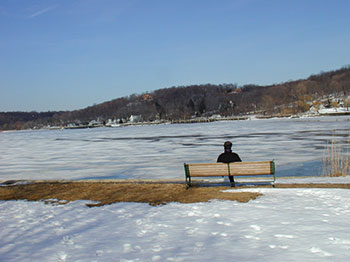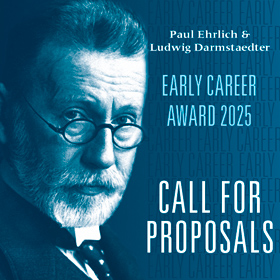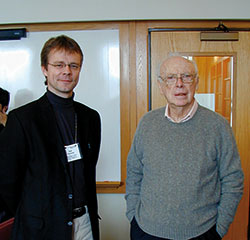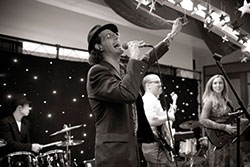US: Cold Spring Harbor Lab on Course to Expansion
Career strategies for young European scientists
by Ralf Schreck, Labtimes 04/2012
The times of whaling ships starting from Long Island are long gone. Nowadays, the fishing for scientific talents and heavyweights from all over the world and for donations are major challenges at Cold Spring Harbor.
Cold Spring Harbor Laboratory (CSHL) was established in 1890 for the education of college teachers in marine biology. Today, it is a private, not-for-profit research and educational institution devoted to molecular biology and genetics. It is located in a small village on the shore of Long Island, less than a one-hour commute from Downtown Manhattan.
The overall research objectives of CSHL are to improve the diagnosis and treatment of diseases including cancer and neurological disorders, and to advance food resources and bio-fuels. Cold Spring Harbor attracts thousands of scientists a year to participate in its distinguished meeting and course programme. But CSHL is not only a place for short-term visits. Not less than eight Nobel Laureates spent a good part of their scientific career over there. Over the decades, Cold Spring Harbor Laboratory has grown steadily with respect to its scientific workforce, the breadth of research topics covered and its scientific impact. Here, Lab Times will provide some details on CSHL and its programmes addressing scientific talent.
Research at its best
Major discoveries have been made not only by the Nobel Laureates affiliated with CSHL. In the early fifties, Barbara McClintock described jumping genes in plants, Alfred Hershey proved that nucleic acids are the genetic material of bacteriophages and the structure of the DNA double helix was proposed by James D. Watson and colleagues. In addition, research on RNA splicing and telomere function led to two shared Nobel Prizes. Recent scientific highlights include microRNAs and their use for diagnosis and treatment of cancer, and the identification of crucial genomic alterations involved in tumour formation and autism as well as the development of an antisense approach to treat spinal muscular atrophy. Research is currently conducted in five broad areas.
Broadening horizons
In the past, the expansion of research topics was almost always linked to the creation of new lab space, either by refurbishment of old or the erection of new buildings. Construction is often facilitated by donations from foundations or individual sponsors. Research in genetics and cancer has been in the focus of CSHL for almost a century. CSHL has been a National Cancer Institute designated Cancer Center for over 25 years. Research in plant biology re-gained momentum in the eighties, whereas neuroscience research was boosted after the completion of the Arnold and Mabel Beckman Laboratory in 1990. Bioinformatics and genomics benefited from the new Cancer Genome Research Center. Recently, a new interdisciplinary programme in quantitative biology was kick-started.
Thomson Reuters published a study last year, in which the number and citations of publications between 2001 and 2011 were analysed. CSHL was ranked number one in the world for its impact in molecular biology and genetics and clearly trumped the Massachusetts Institute of Technology or the Salk Institute for Biological Studies. In the latest SCImago Institutions Ranking, which depends primarily on the publication output between 2005 and 2009, CSHL just made it into the first 2,000 institutions worldwide. But that its 1,018 publications were above average quality was revealed, when the same set of data was scrutinised from a different angle. In the Excellence Ranking, which puts more weight on the top ten percent of most cited papers in the respective scientific field, CSHL was number four in the world, only beaten by the Whitehead Institute for Biomedical Research, the Howard Hughes Medical Institute and the Broad Institute of the Massachusetts Institute of Technology and Harvard.
Steady growth in all areas
CSHL is growing slowly but steadily. Over the last two decades, the number of employees more than doubled and the annual research budget increased more than fivefold. Its operating budget will pass $150 million for the first time this year. Federal grants account for 38% of the budget but exhibited a decline over the last years, which pertains also for corporate contributions. In contrast, donations by foundations and individuals are on the rise and constitute almost a quarter of the whole budget. CSHL puts an extra effort into securing such funds and has developed numerous fundraising events including special dinners, a golf tournament and “Labapalooza” featuring scientist rock bands.
According to the Internal Revenue Code CSHL is a public charity. Donors may contribute a few bucks as a one-time online payment or may be listed at the top end of the donors' honour role for making a contribution of $5 million or more in the respective year or during a lifetime. Half of the annual CSHL budget is for unrestricted use, which allows some flexibility in research spending and the support of unconventional ideas and high-risk projects.
A Nobel Laureate director
The number of current CSHL employees is close to 1,200. There are 53 faculty members, 170 postdocs and 120 graduate students. CSHL was headed by Nobel Laureate James D. Watson as Director from 1968 to 1994. Since then, Bruce Stillman, who is known for his work on DNA replication, became first Director and was named President of CSHL in 2003. CSHL is governed by a 35-member Board of Trustees. Board members are business and community leaders or scientists from major educational and research institutions.
Besides its groundbreaking research, CSHL is widely known for its Meetings & Courses Program. About 60 three- to five-day meetings and one- to three-week courses bring together more than 12,000 scientists each year to discuss the latest developments in biology and biomedical research or to learn state-of-the-art methods and techniques from leading experts. This is not only done on its Long Island premises. In the meantime, Cold Spring Harbor Asia Conferences are held at the Dushu Lake Conference Center in Suzhou, sixty miles west of Shanghai, China. Meetings are partially supported by grants from the National Institutes of Health, the National Science Foundation and the CSHL Corporate Sponsor Program. Core support for courses is provided through a grant from the Howard Hughes Medical Institute. As graduate students or postdocs you may apply to one of the close to 800 partial stipends that are granted to Meetings & Courses participants each year.
At the end of my own PhD thesis, a trip to a CSHL meeting sponsored by my thesis advisor was quite a profound experience. After decades, I still remember a couple of things: aching knee joints from the flight and dozens of hours spent in the lecture hall, the fierce discussions of established scientists sitting in the front row and challenging the results of the newbies, who made it to the speakers' list, the traditional party when hundreds of lobsters are served at the same time, and the noisy puddle, they called a swimming pool, an arm’s-length to a major highway at my nearby hotel. The Banbury Center is a small conference centre in the neighbourhood, hosting world-leading workshops on the impact and future of molecular biology, genetics, neurosciences and science policy. Participation in these workshops is limited to a maximum of 30 to 40 attendees, is by invitation only and takes place without the public and under strict confidentiality agreements.
Manuals and more
CSHL Press was created as a division of CSHL in 1933. Each year, close to nine million research articles are downloaded from its seven journals and 40,000 printed books are sold. Genes & Development with a five-year impact factor around 14 and Genome Research are widely known journals from CSHL Press and leading publications in their respective fields. Lab manuals from CSHL Press have become indispensable tools for the daily lab routine: first and foremost the “bible” of molecular biology, which started as a single $40 volume, entitled “Molecular Cloning” or simply the “Maniatis” in 1982. It has gone over the counter more than 200,000 times and was based on protocols of a CSHL course on molecular cloning of eukaryotic genes. The 2nd and 3rd editions were published in 1988 and 2001, respectively, reflecting the high standard and timelessness of its contents or just the unwillingness of the high-profile author team to devote more time to updates. The 4th edition has just been released and encompasses now more than 2,000 pages at a steep price of $365 for the paperback and $475 for the hardcover version. Other top sellers include At the Bench – A Laboratory Navigator, RNA – A Laboratory Manual and the recently released second edition of Lab Dynamics – Leadership Skills for Scientists.
Photos from the past
Another point of interest is the Archives section at CSHL. It was established in 1972 and serves as a repository of rare materials including manuscripts and photos documenting the history of genetic research at CSHL and beyond. The collection is open to everyone interested in historical aspects of genetics. It is definitely fun to have a closer look into the digital collections, providing amongst other documents black and white photos of the early pioneers or snapshots taken by scientists while visiting the famous Cold Spring Harbor Symposia on Quantitative Biology, which was launched already in 1933. As part of the Archives, the Genentech Center for the History of Molecular Biology and Biotechnology was established in 2006 by a $2.5 million donation from the company. The mission of the Genentech Center is to locate, acquire and digitise original papers, correspondence and research material of people and institutions crucial to the development of molecular biology and biotechnology. The Center is also in charge of the Oral History Collection consisting of more than 175 video interviews with leading experts in genetics, biotechnology and molecular biology.
Fostering the scientific talent
Education in science and the promotion of scientific talent remain an utmost concern to CSHL. The DNA Learning Center is visited by 30,000 middle and high school students and 8,500 high school teachers per year and provides hands-on experience in molecular biology. It operates at three different locations: the Dolan DNA Learning Center on Main Street in Cold Spring Harbor, the Harlem DNA Lab and the DNA Learning Center West in Lake Success. CSHL is chartered as an education and research institution by the Education Department of the State of New York. It is authorised to operate a graduate programme under the name “Cold Spring Harbor Laboratory, Watson School of Biological Sciences” and to confer Master and doctoral degrees. In addition, a shared graduate programme with the State University of New York at Stony Brook is offered.
The Watson School of Biological Sciences (WSBS) launched its four-year PhD programme in 1999. The academic programme at WSBS was recently rated excellent in a comprehensive analysis of more than 5,000 doctoral programmes by the National Research Council. Admission to WSBS takes place once a year and only about ten to twelve new PhD students are admitted per application round. Students from abroad are encouraged to apply but the competition is stiff and the programme 15- to 20-fold oversubscribed. Candidates are selected on the basis of their academic record, letters of recommendation and a personal interview. WSBS also provides funding for the PhD students and also covers research-related costs in the four-year-period. The annual stipend amounts to $30,500. In addition, subsidised on-site or off-campus housing is offered to all students.
Learning from Watson
In the first year, phases of course work and lab rotations have to be completed. A two-tier mentoring programme is in place and encompasses a research mentor being the doctoral thesis advisor and an additional academic advisor providing more general advice and support. An impressive number of more than 190 papers have been published by CSHL doctoral students so far and close to 50 students have received their doctoral title since the inception of WSBS. Another proof for the high quality of doctoral training is evident from the alumni page. After receiving their doctorates, most scientists pursue an academic career in preeminent institutions and only a few join companies, such as Roche or Genentech or leave research to become, for example, an assistant editor for Nature Genetics or programme manager at McKinsey & Co.
Several programmes are in place to support scientific talents at a later stage. The CSHL Fellows Program is targeting outstanding young scientists with a recent doctoral degree wishing to pursue a period of independent research, before taking a faculty position. Fellows are guided by a senior faculty member, have their own lab space, a technician and access to CSHL resources. Appointments are initially for three years with the possibility to extend for up to two additional years. Applications are possible at any time and encompass a letter of introduction, a CV and the names of four colleagues able to provide letters of recommendation. In addition, nominations by PhD student advisors are accepted.
The CSHL Clinical Fellows Program supports clinicians who have finished their clinical training and certifications. Provided are well-paid fellowships to conduct research in a CSHL lab for up to three years. Applications and nominations are similar to the Fellows Program. In early June of this year, just one current CSHL Fellow, Justin Kinney, who received his doctoral title from Princeton University in 2008 and is associated with the CSHL quantitative biology programme, and no current Clinical Fellow, was listed.
Vital course programme
Postdocs are taken care of by the CSHL Postdoc Program Office. Educational and career development activities are organised by its scientific director Nicholas Tonks and administrator Alyson Kass-Eisler. Courses are offered, for example, on grant writing or leadership training. CSHL is member of a special ambassador recruitment programme of Merck Research Laboratories. By this programme, CSHL PhD students and postdocs are connected to scientists working at the company and some are hired by the company after their CSHL experience. CSHL postdocs are also enrolled in the Science Alliance, an initiative of the New York Academy of Science, which brings together various institutions in the New York City metropolitan area and provides additional career and professional development opportunities, as well as social and cultural activities, which may be used to find the next employer. Postdocs interested in joining CSHL should contact CSHL faculty members direct. Open postdoc positions are also posted online in the CSHL Careers section and the Postdoc Office will provide some help in finding the right source of funding.
Outlook
CSHL has mastered the art of expansion, even in times when federal research budgets are being cut. The established mix of different income sources seems to make it less vulnerable to sudden economic changes. Therefore, in contrast to many other places in the US, scientists at CSHL speak about science first and do not constantly carp about poor career prospects and declining research budgets.
For the scientific talent from abroad it is a big challenge becoming a PhD student at Cold Spring Harbor due to the small size of the graduate programme. However, there seem to be many opportunities to join CSHL as a postdoc. If you bring along your own fellowship and fit into the research focus of a particular group, it should not be too difficult to become one of the 150 plus postdocs at CSHL. Enjoy the view of the bay and take advantage of the excellent conditions for doing research at an institution with an outstanding reputation.
Internet Resources
Last Changed: 13.07.2012










